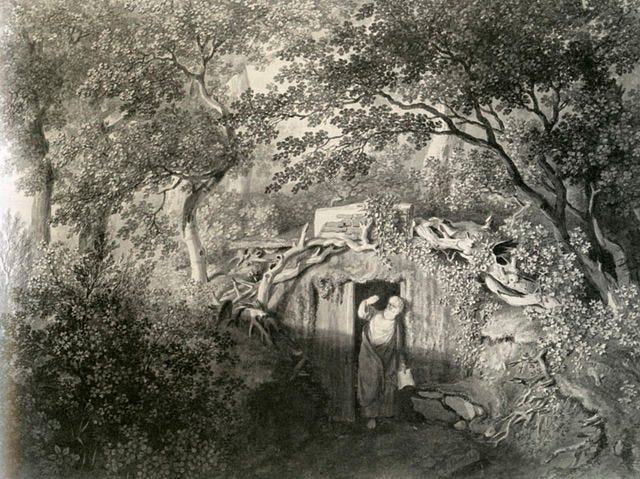Of course, I’m talking about garden gnomes.
Those silent g-having faux-furry little creepy beasts that adorn so many of our front lawns, lord knows why.
But rewind 300 years ago, and you probably wouldn’t have wanted to spill one of their guts out on the ground. There’d be a lot more blood and probably a few screams.
Garden Rich
Back in the 18th Century, France and England had a problem. Or to be more specific, their uber-rich people had a problem.
Too much money and nothing to do with it. (Tough life, right?)
Building giant, grandiose estates seemed to be the only solution among this cohort of the elite. Other than building factory upon factory to extort the working class, of course.
As the centuries wove by and the need to one-up your maybe-slightly-richer neighbor became a pressing need, the idea of elaborate gardens started to evolve.
Over in France, we would see a sort of logical beauty that any modern nerd…ahem, programmer, would have an appreciation for.
Vast fields of green surrounded by bushes. Stone-covered pathways flow in geometrical order around the estate.
No flower, bush, or tree seemed out of place. Utter perfection.
An opium den for OCD.

But what does one do when they reach perfection in physical layout?
Blow logic out the window, of course.
What to do?
There were a few new-age solutions to consider for those looking to expand on their garden coolness factor.
Some went with elaborate and possibly confusing mazes:

Others added lots of bridges, winding paths, and small buildings imitating a style seen in China at the time.
Collectively, this style of garden architecture was known as Chinoiserie and resulted in some amazingly integrated styles of garden estates at the time.

But if you were really the who’s who of gardens at the time, and you really wanted to impress your friends for no other reason than bragging rights, you needed to get your bougie hands on a bonafide real-life hermit.
Use Your Imagination
The more elaborate gardens of the time were often described as magical.
A winding path leading into a dark forest with butterflies fluttering about? Surely, there must be fairies around.
Or perhaps the hint of golden colors sparkling in the stones of the walkway imply there’s a leprechaun or garden-elf nearby, ready to shower his riches on those that would venture near.
Regardless of the imagination of the visitor, the wealthy knew the awe-inspiring power of a magical garden — and the admiration that would bestow upon the owner.
It was a simple task, really.
You just needed to follow a few simple rules:
- Find a reclusive corner or nook in your massive garden estate
- Construct an ancient-looking hermitage, folly, grotto, or rockery
- Put an ad in the local newspaper asking for someone to come live there full-time for seven years without being allowed to leave, talk to anyone, but willing to be paid the equivalent of $80,000 in today’s money (for the entire time)
It also helps if the resident hermit would be willing to grow a long white beard, never shower or bathe (probably not a problem at the time), and be willing to put on a bit of a performance when random rich people come to visit.
Follow the above steps, and you could find yourself the proud owner of hermitages like:

Or a mock ancient forest hut seemingly built into the trees in Germany:

Or perhaps you want something a bit more straight out of Lord of the Rings? Don’t worry, you can build whatever you want — you’re an 18th-century aristocrat!

A live-in hermit was once hired by someone named The Hon. Charles Hamilton. He had just purchased a massive estate and had the entire thing rebuilt in the most neighbor-impressing fashion imaginable, complete with a grotto, a folly, AND a hermitage — but no hermit.
Imagine his pure joy when the final piece of his missing puzzle was accepted! A local man who may or may not have had a drinking problem showed up one day, threw his signature down on a 7-year contract, and started growing his rustic grey beard.
Three weeks later, he was discovered in a local pub at night. Sadly, the hermit was fired.
But don’t let that discourage you completely, other aristocrats found another solution to the labor shortage — automatons!
J.J. Pryor
Want more fun stories? Join Pryor Thoughts for free today!
References:
- https://en.wikipedia.org/wiki/Garden_hermit
- https://en.wikipedia.org/wiki/French_formal_garden
- https://www.ft.com/content/66eae9bc-8999-11e3-8829-00144feab7de
- https://www.theguardian.com/comment/story/0,3604,712137,00.html
- https://www.mentalfloss.com/article/500916/short-lived-british-fashion-ornamental-hermits
- https://en.wikipedia.org/wiki/Chinoiserie
You might also be interested in reading about what is a Potemkin village.



